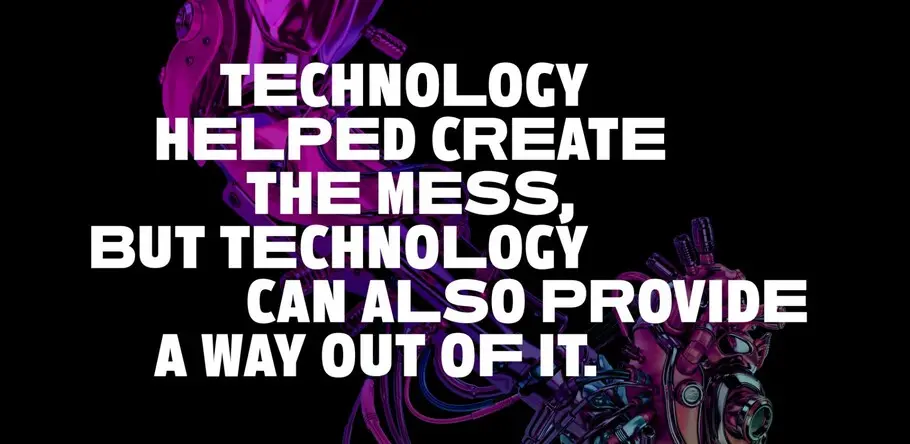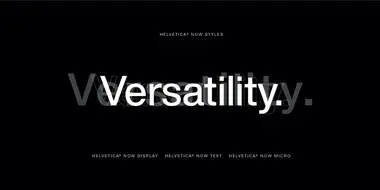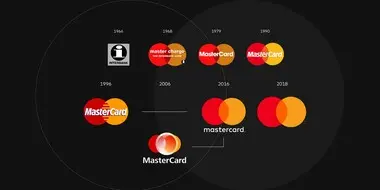How fonts can help you win the technology race.

We all know that fonts are essential to providing clear communications everywhere your brand appears. But it’s also safe to say that fonts are more important now than ever. Brands today are connecting with their customers across countless touchpoints—from huge LED billboards to smartwatch apps to magazine ads—and all signs point to that ecosystem expanding in the years to come.
This explosion of consumer touchpoints and consumer technology has made licensing fonts properly a complicated and sometimes confusing task. Different fonts are engineered and optimized for different environments, and each type of font comes with its own license structure. This, of course, leads to a host of questions. Can you use the same font license for that huge LED billboard and the tiny smartwatch? How do you know if the licenses you have cover the usage you need?
Sorting out these different scenarios can be a frustrating and time-consuming process. Brand owners and creatives essentially have to be experts in licensing and IP. Creative work needs to be vetted to ensure the correct fonts are used. And if the wrong fonts are used, published creatives have to be redone, sometimes recalled, and can even lead to improper use of fonts or infringement of licensing.
If that sounds exhausting, well, it is. But it isn’t the whole story.
Opportunity, at a cost
All this change has opened up countless opportunities. Long gone are the simpler days where print ads and TV made up the bulk of a brand/customer “relationship.” Today, brands can connect with customers in a more personal, human way, creating durable relationships that benefit both sides.
“We’ve never faced such a relentless phase of growth,” says Monotype Senior Director, Creative, James Fooks-Bale. “Customers are engaging with brands in more places than ever, from geography to the device or channel they’re using. By the time you think you have things set, a new device, platform, or form of content creation has been added to the pile.”
“Brands have to evolve at a rapid and continual rate, whether that’s a technological shift, new audience or way of segmenting a new market or localization,” Fooks-Bale added. And, they have to do that without sacrificing who they are, what they stand for, or the consistency of their established brand experience.
These new opportunities come with a fair amount of challenges. Each new device or touchpoint needs its own batch of creative assets—fonts, images, music, and so on—and these creative assets all need to be licensed appropriately for each specific use. Technology has also trained consumers and brands alike to expect instant gratification. When so many things can be done quickly, the thinking goes, why can’t everything be done quickly?
This puts a lot of pressure on creative teams. Competing in the modern world requires you to be everywhere, instantly, all the time. But the reality is that developing new products and campaigns takes time, and the old approach to creative assets like fonts is out of step with today’s technological demands. This is how brands find themselves entangled in font licensing and, potentially, dealing with some disruptive consequences:
- For creative and marketing teams: Losing time while searching internal files for the properly licensed fonts; waiting for licenses to be procured (or scrambling to get them quickly); recreating work that used fonts without the appropriate licenses; pulling down published campaigns or assets that used the wrong license.
- For procurement teams: Having to check with other teams to make sure up-to-date font licenses are being used; finding out after the fact that new fonts have been purchased without proper approval; maintaining visibility into who within the organization is accessing, using and sharing creative assets.
- For legal teams: Worrying about outdated or incorrect fonts being used; dealing with infringement cases; worrying about where fonts are procured; concern over indemnification (or lack thereof) for purchased fonts.
For brands trying to keep pace with their customers, these delays not only cost them time and money, but can also lead to friction among teams and breakdowns in the creative process as different stakeholders seek approvals and visibility into how fonts are used.
But if technology helped create this mess, technology can also provide a way out of it.
A way forward
Modern brands who lean into the opportunities offered by today’s technology also need to lean on systems built for that environment. The solution for most brands is a system that can flex and expand, allowing them to adapt to new technologies and consumer demands.
We created Monotype Fonts to address these needs and remove the friction and stifled creativity that having disparate solutions (or no solution) creates. As a cloud-based solution, team members can log in from anywhere and have immediate access to your brand’s library of fonts—including fonts you licensed from non-Monotype providers. This means team members don’t have to save font files on their personal workstations, which mitigates the risk of using outdated fonts or the wrong font entirely.
From there, perhaps the most important element brands need is organization. Finding the right font should be a no-brainer, so your creatives can quickly and easily get what they need and verify that it’s the correct file for the project. Monotype Fonts allows you to organize your fonts in whatever way your organization thinks best—for example, by “project,” which your team defines however it likes. In practical terms, a designer working on digital ads can go to the project labeled “digital ads” and find exactly what she needs, and only what she needs. This greatly reduces the risk of someone using the wrong fonts and allows creative teams to work quickly, without getting bogged down in a search for the correct file.
It’s also important for procurement teams to have visibility into who is using your fonts. Monotype Fonts addresses this by allowing administrators to assign customizable access levels to different users. You may want to grant access to the full library in some cases, but restrict access in others. For example, you may allow some designers to install only the fonts they need, which is especially useful when collaborating with third-party vendors, including printers, freelance designers, or temporary contractors.
Monotype Fonts also provides your team with access to Monotype’s full library of more than 250,000 fonts. Every font in that library comes with an unlimited desktop license, so your creative teams can experiment with new designs before deciding if they want to add new fonts to your organization’s repertoire. Easy experimentation allows your team to respond quickly to new opportunities, and Monotype Fonts makes it simple for procurement teams to license those fonts for broader use.
The goal is to provide your team with the peace of mind necessary to be as agile and innovative as modern technology demands. Your creative teams will no longer question what they can and can’t use, or start projects they have to scrap halfway through; your procurement team will have visibility into what fonts are being deployed where, and by whom, all but eliminating the possibility of rogue usage; and your legal team can rest easy knowing the risk of infringement is low.
All of this allows you to focus where it really counts: Providing a superior customer experience, and making the most of the opportunities technology offers without the complications technology can cause.
To learn more about Monotype Fonts can help take the guesswork out of font licensing, drop us a line and we’ll get in touch.













